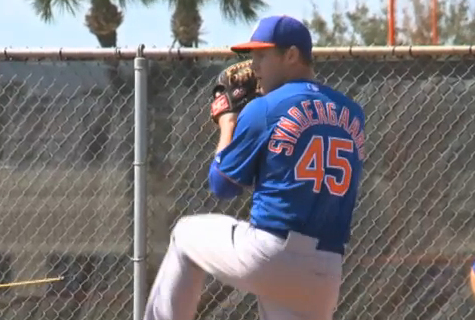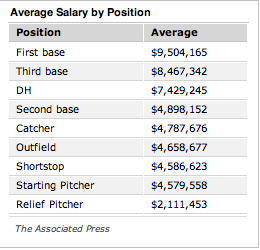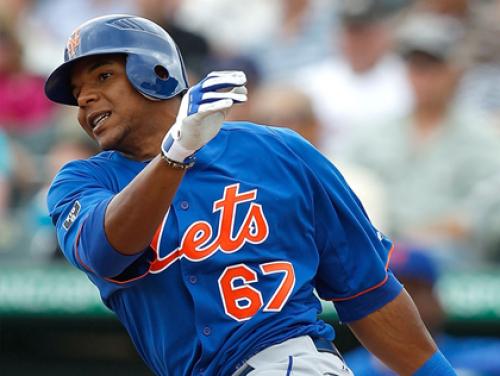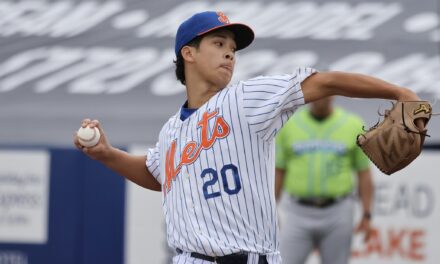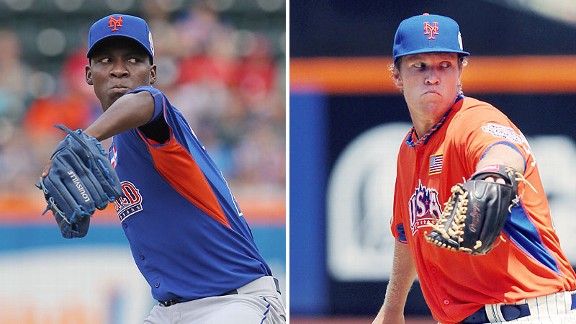 If there is one thing the Mets have going for them it is the very exciting crop of young pitchers in their farm system. The Mets have made some highlights this week after Keith Law, of ESPN, ranked the organization’s farm system as sixth-best in baseball.
If there is one thing the Mets have going for them it is the very exciting crop of young pitchers in their farm system. The Mets have made some highlights this week after Keith Law, of ESPN, ranked the organization’s farm system as sixth-best in baseball.
It seems that the strategy to stockpile as many promising young pitchers as they possibly can is paying off, and now some of the offensive players are getting more recognition.
The question is whether or not it is a smart move to build your farm system around pitching, and there are a number of reasons why one would question it.
Nothing excites Mets fans more than thinking about Noah Syndergaard, Rafael Montero, Jenrry Mejia, and Zack Wheeler joining Matt Harvey in the rotation in the coming years. But the truth is, as Matt Harvey has shown this year, your ace can be lost for an entire season in the blink of an eye. In fact, a study conducted during 2010 found that pitchers are 34% more likely to hit the disabled list than a position player, and pitchers also spend more time on the disabled list (62.4% of the time versus 37.6% for position players).
The old adage states that good pitching beats good hitting, but there should be an asterisk next to that statement. There should be an asterisk next to that statement because I don’t care how good your pitchers are, you can’t win a game if your offense doesn’t produce runs. Now depending on who you speak to, there are many different schools of thought on how to generate runs. However, the best formula for scoring runs is having good offensive players in your lineup.
Hitters are more predictable over time. Hitters tend to produce pretty consistently until they start getting up into their early 30s. Pitchers, on the other hand, are a lot more difficult to predict. R.A. Dickey, although a knuckle baller, is a prime example of that unpredictability. That is because much of a pitcher’s success can be determined by many more outside factors than a hitter’s can—like the defense of their teammates.
Is it cost effective to develop as much young pitching as possible?
When looking at the average salaries of position players taken from the Associated Press in 2010 (shown below), you would think not. By not developing offensive players, you are forced to go shopping in the free agent market, and susceptible to some of the costs displayed in the graphic. From looking at this chart, I could sign two pitchers for the cost of signing one first baseman (on average)—so why wouldn’t I opt to develop my own offensive talent and instead add pitchers in free agency?
There was an article on MMO awhile back regarding Theo Epstein and how he is always trying to get one step ahead and trying to stay ahead of the curve (no pun intended). I had the opportunity to cover the Chicago Cubs last year as a Featured Columnist for Bleacher Report, and the truth is, the Cubs farm system is the total opposite of the Mets.
Instead of being stocked with pitchers, they have some of the more exciting offensive players in the game today in their farm system—Kris Bryant, Dan Vogelbach, Jorge Soler, Javier Baez, Mike Olt and Albert Almora are a very solid foundation to build their future around…very solid. They have some nice pitching prospects, but they have an abundance of offense.
Which system is better?
Keith Law had the Cubs ranked No. 4 on his recent list of top farm systems. As Mets fans already know, he had the Mets ranked sixth, and that was much higher than what many people thought it would be—I haven’t heard many complaints about where the Cubs’ system is ranked.
Offense sells tickets. And while pitching may win you a World Series, offense will get your team to the playoffs. If you don’t get to the playoffs, you can’t win a World Series.
When taking everything into consideration, is it wise for a team build their system around pitching?
The Mets have some promising young offensive players, but even those prospects have some pretty big question marks hanging over their head—Wilmer Flores doesn’t have a steady position defensively and didn’t even crack Law’s top 100 list, Travis d’Arnaud hasn’t played a full season since Double-A, and now we’re hearing that Mets’ scouts don’t even consider Cesar Puello a prospect. The remainder of the Mets big-time offensive prospects (like Brandon Nimmo, Dominic Smith—both named to Law’s top 100) are still a couple of years from helping out the team at the big league level.
So what the Mets have is good pitching, and lots of it. We are left wondering what the Mets will do with all this pitching since there are only a limited number of pitchers you can carry on the major league roster, and how many insurance policies are you going to carry in case someone gets hurt? Will the Mets start flipping some of these pitchers while they are hot to reap some offensive rewards? All it takes is one injury to destroy the value of one of these young pitchers.
If the Mets were smart they would sell high, and bring in some offense now. The only Mets pitcher that should be untouchable in the farm system right now is Noah Syndergaard. Syndergaard is one of the brightest Mets pitching prospects I have seen in awhile, and the Mets would be wise to keep young Thor and transform Citi Field to a virtual Aasgard in the near future.
If the Mets continue to build around pitching, and a few of those guys get hurt and wash out, they are left with nothing—no offense and no pitching. The odds of a pitcher getting injured is about 40% more likely to occur than a position player. Not only that, but a position player helps my organization every day, and pitchers can only impact about 30 games per year.
The Mets have their philosophy in place, and a bank account full of young pitchers which many believe leaves Sandy Alderson sitting on a stack of gold bars. But pitchers aren’t like gold bars, they are more like internet stocks—their value can come crashing down in one pitch, and the Mets pitching prospect bubble will burst leaving them with a whole bunch of nothing. It’s time to start unloading some of this volatile stock and get some long-term value in offense in return.

